The enormous, interlinked web that is the organizational goal alignment process can seem daunting at first glance. But as we’ve been discussing, successful goal alignment can be achieved with the right roadmap and technology. Setting up your own roadmap doesn’t have to be a headache if you do your homework (and we’ve got plenty of resources to help you get there). To give you a head start on learning how to align performance for success, here are six goal alignment examples every manager should know for successfully aligning goals.
#1. Know organizational goals like the back of your hand
Half of the workforce doesn’t strongly feel they know what is expected of them. Don’t become a part of that problem. Managers are typically those who plan and delegate employees’ goals to align with organizational goals. For that reason, understanding the mission of every organizational goal, even those which they might not directly be responsible for, will make aligning goals happen more seamlessly.
Tip: Familiarize yourself with the other managers or leaders who are setting goals of their own. Find out problems or reasons driving these new organizational goals and if your team can in some way be a part of the solution.
Build an understanding of your organizational goals starting with these steps:
#2. Get leadership behind goals
One surefire way to sabotage successful goal alignment is presenting goals to employees without consensus from each member of the leadership team. In their 2013 Change and Communication ROI survey, Towers Watson found that 75% of change initiatives fail. Why? It turns out that only 68% of senior managers understand the reasons behind organizational goals. Everyone must have transparency into company strategy, issues at hand, and who is responsible for what in order to be successful not only in aligning around goals but also in accomplishing them.
Tip: Coordinate with colleagues to make sure the messaging of the goal alignment process is communicated accurately and consistently across each responsible department.
Also read: Why Aligning Corporate Goals Takes More than Just Software
#3. Follow through on established standards
Part of successful goal alignment is staying true to company values and standards when planning and implementing goals on any level. Lacking consistency in the standards and expectations employees are held to in their day-to-day tasks and especially when carrying out projects, leads goals down the wrong path and contradicts company guidelines. Things like the chain of command, standards of quality, and the amount of work expected to be completed must be clarified and consistent. 70% of employees who lack confidence in their leadership are disengaged. You’ve established trust with your teams, don’t break that trust with inconsistent standards.
Learn how to set aligned employee goals for performance success:
Tip: When setting goals, establish standards first, not last, and make sure employees are educated on them before they are assigned goals. Avoid making significant changes once they have been implemented. If change is necessary, for example, if key members of the team are leaving the company, carefully outline why the change is happening, how it impacts each person’s job and what will change in the goal process moving forward.
#4. Support employees in achieving goals
Upwards of 50% of employees don’t feel their manager helps remove obstacles to doing their job better? For organizational goal alignment to be successful, employees need the right resources, guidance, and plans to help them realistically meet goals.
Tip: Managers have to be extremely well-versed in the capabilities of their team members, making sure goals are appropriate and, if needed, supported with tools to facilitate success.
Check out: Why Goals Fail
#5. Assign accountability measures
While your performance management system should have a goals dashboard to keep each person accountable for their own responsibilities in the goal alignment process, ensuring those individual goals and deadlines are appropriate is the key to success. Did you know employees are seven times more likely to be engaged when they report that their managers are aware of the tasks and projects that they are working on? In case you skimmed over that, I said seven times more likely.
Tip: Avoid keeping your thoughts about the goal-setting process to yourself. Share them with colleagues and discuss them with each team member during the goal-setting stage so that everyone is in agreement on the parameters of objectives and deadlines.
Employees are 7 times more likely to be engaged if managers do this:
#6. Guide the goal alignment process with regular communication
Aligning goals isn’t something managers can just be done with once the wheels are in motion. Like everything in life, there will be bumps along the road that can cause projects to derail, deadlines to be pushed back and responsibilities shifted around.
Tip: Create an environment of open communication with your team so they can voice concerns about their progress. Gallup research shows that 60% of employees with managers who are open and approachable are more engaged in their work. That’s a win-win for you! On that same note, don’t be afraid to seek the help of your colleagues or offer a helping hand to keep the goal alignment process on track.
Want your company’s goal alignment process to be successful? Be part of the solution by keeping these six goal alignment examples in mind.
Let us help you build your roadmap to aligning performance for success by snagging your free copy of our goal alignment whitepaper today! Download the whitepaper here.
For onboarding tips, check out our Employee Onboarding Guide.
Related Posts:

.png)
